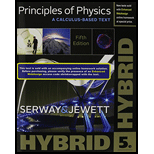
(a)
The specific heat of air at constant volume.
(a)
Answer to Problem 43P
The specific heat of air at constant volume is
Explanation of Solution
Given Info: Temperature of air is
Formula for calculating the gas constant is,
Here,
Substitute
The specific heat at constant volume in
Substitute
Thus, the specific heat at constant volume is
Conclusion:
Therefore, the specific heat at constant volume is
(b)
The mass of the air in the cylinder.
(b)
Answer to Problem 43P
The mass of the air in the cylinder is
Explanation of Solution
Given Info Temperature of air is
According to the ideal gas equation,
Here,
Rearrange the above equation for
Substitute
The number of moles of a gas is,
Here,
Substitute
Thus, the mass of the air is
Conclusion:
Therefore, the mass of the air will be
(c)
The energy input required to raise the temperature to
(c)
Answer to Problem 43P
The energy input required to raise the temperature to
Explanation of Solution
Given Info: Temperature of air is
As the piston is held fixed, therefore, the process will be of constant volume.
The energy input for the given condition is given as,
Here,
Substitute
Thus, the energy input required is
Conclusion:
Therefore, the energy input required will be
(d)
The energy input required to raise the temperature to
(d)
Answer to Problem 43P
The energy input required to raise the temperature to
Explanation of Solution
Given Info: Temperature of air is
As the piston is free to move, therefore, the process will be of constant pressure.
The energy input for the given condition is given as,
Here,
The expression for gas constant for any ideal gas can be given as,
Substitute
Substitute
Thus, the energy input required is
Conclusion:
Therefore, the energy input required will be
Want to see more full solutions like this?
Chapter 17 Solutions
Principles of Physics: A Calculus-Based Text, Hybrid (with Enhanced WebAssign Printed Access Card)
- Hi! I need help with these calculations for part i and part k for a physics Diffraction Lab. We used a slit width 0.4 mm to measure our pattern.arrow_forwardExamine the data and % error values in Data Table 3 where the angular displacement of the simple pendulum decreased but the mass of the pendulum bob and the length of the pendulum remained constant. Describe whether or not your data shows that the period of the pendulum depends on the angular displacement of the pendulum bob, to within a reasonable percent error.arrow_forwardIn addition to the anyalysis of the graph, show mathematically that the slope of that line is 2π/√g . Using the slope of your line calculate the value of g and compare it to 9.8.arrow_forward
- An object is placed 24.1 cm to the left of a diverging lens (f = -6.51 cm). A concave mirror (f= 14.8 cm) is placed 30.2 cm to the right of the lens to form an image of the first image formed by the lens. Find the final image distance, measured relative to the mirror. (b) Is the final image real or virtual? (c) Is the final image upright or inverted with respect to the original object?arrow_forwardConcept Simulation 26.4 provides the option of exploring the ray diagram that applies to this problem. The distance between an object and its image formed by a diverging lens is 5.90 cm. The focal length of the lens is -2.60 cm. Find (a) the image distance and (b) the object distance.arrow_forwardPls help ASAParrow_forward
 Principles of Physics: A Calculus-Based TextPhysicsISBN:9781133104261Author:Raymond A. Serway, John W. JewettPublisher:Cengage Learning
Principles of Physics: A Calculus-Based TextPhysicsISBN:9781133104261Author:Raymond A. Serway, John W. JewettPublisher:Cengage Learning
 Physics for Scientists and Engineers: Foundations...PhysicsISBN:9781133939146Author:Katz, Debora M.Publisher:Cengage Learning
Physics for Scientists and Engineers: Foundations...PhysicsISBN:9781133939146Author:Katz, Debora M.Publisher:Cengage Learning Physics for Scientists and Engineers, Technology ...PhysicsISBN:9781305116399Author:Raymond A. Serway, John W. JewettPublisher:Cengage Learning
Physics for Scientists and Engineers, Technology ...PhysicsISBN:9781305116399Author:Raymond A. Serway, John W. JewettPublisher:Cengage Learning College PhysicsPhysicsISBN:9781285737027Author:Raymond A. Serway, Chris VuillePublisher:Cengage Learning
College PhysicsPhysicsISBN:9781285737027Author:Raymond A. Serway, Chris VuillePublisher:Cengage Learning College PhysicsPhysicsISBN:9781305952300Author:Raymond A. Serway, Chris VuillePublisher:Cengage Learning
College PhysicsPhysicsISBN:9781305952300Author:Raymond A. Serway, Chris VuillePublisher:Cengage Learning





